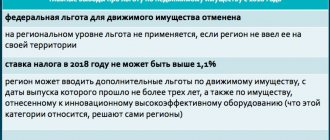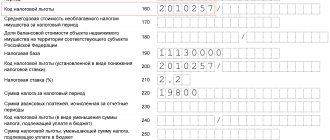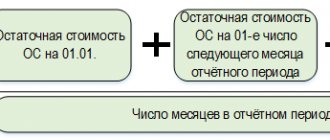The President signed a law on a new procedure for calculating property taxes for individuals. With the entry into force of the new law in Russia, the procedure for calculating the tax that citizens pay for their real estate: houses, apartments, land plots, garages and parking spaces is changing. How will the property tax of Russian citizens now be calculated, starting in 2021? What coefficient is used when calculating tax? How will the cadastral value when taxing real estate?
To whom and what benefits are provided when paying property tax - apartment, land plot, parking space.
New formula for calculating property taxes starting in 2021.
Examples of property tax calculations. This document is intended to curb the increase in payments to owners caused by the cadastral reform. The head of state ordered this to be done based on the results of his Address to the Federal Assembly in March of this year. It was previously reported that work is underway to revise the calculation of property taxes.
New coefficient for the third year according to the cadastre
Please note the following list of subjects of the Russian Federation:
For their residents who own taxable property, a cadastral valuation is used when calculating tax for the third year. Therefore, for the period of 2017 the coefficient has changed: it is 0.6 instead of 0.4 for the previous year 2016.
However, tax authorities do not apply this coefficient in two cases:
- If the tax calculated based on the inventory value exceeds the corresponding amount based on the cadastral value.
- The object belongs to those listed in paragraph 3 of Art. 402 of the Tax Code of the Russian Federation (trade and office buildings, etc.).
Also see What's New in 2021 Tax Notices.
Calculation
Tax obligations on real estate owned by citizens of the Russian Federation are calculated either by cadastral or inventory valuation.
If the tax is calculated based on inventory value, then the deflator is taken into account as follows:
SIS (total inventory value of all real estate owned) × CD (deflator coefficient) = tax base. From the resulting tax base, the actual amount of tax payable is determined depending on the established tax rate.
When calculating the tax amount, the actual number of months of ownership of the property is taken into account. That is, if at the time of calculating the tax base the ownership period is less than a year, then the calculation is made by dividing these months by 12.
In addition to the length of ownership, an indicator such as ownership of not the entire property, but its share, is taken into account. In this case, the size of the share is included in the calculation.
New coefficient for the second year according to the cadastre
Here is another list of Russian regions in which the Federal Tax Service calculates the property tax of individuals for 2017 in its own way:
Here the cadastral value is used for the second year. Accordingly, the coefficient for the 2017 tax period has changed: it is 0.4 instead of 0.2 for 2021.
Again, this coefficient of 0.4 is not used by tax authorities in two cases:
- The tax calculated based on the inventory value exceeds its corresponding amount based on the cadastral value.
- The object belongs to those listed in paragraph 3 of Art. 402 of the Tax Code of the Russian Federation (trade and office buildings, etc.).
The procedure for applying cadastral value when taxing real estate
From January 1, 2021, the procedure for using cadastral value when taxing real estate will be changed. The corresponding law was signed by the President of the Russian Federation and published on Friday, August 3 on the official Internet portal of legal information (Federal Law of August 3, 2021 No. 334-FZ “On Amendments to Article 52 of Part One and Part Two of the Tax Code of the Russian Federation”).
The law introduces uniform rules for the use of cadastral value when determining the tax base for land tax, corporate property tax and personal property tax. From 2021, real estate taxation will be carried out only on the basis of the cadastral value entered into the Unified State Register of Real Estate. And also in the event of its change as a result of establishing the market value of the property by decision of a commission under the Rosreestr body or a court.
In the event of a change in the qualitative or quantitative characteristics of the taxable object, the adjustment of the cadastral value will be taken into account from the date the information is entered into the Unified State Register of Real Estate, which is the basis for the adjustment. When a technical error is corrected in the Unified State Register or reduced due to the correction of other errors, the new amended cadastral value will be applied from the date from which the information about the erroneous cadastral value was applied. If the specified value changes based on the establishment of the market value of the object by decision of the commission or court, then information about the changed value will be taken into account from the date of application of the disputed cadastral value when determining the tax base.
Such rules will apply to information about changes in cadastral value entered into the Unified State Register of Real Estate on grounds that arose from January 1, 2021.
First year according to the cadastre
And these are the pioneer regions:
For their residents, property tax for individuals for the first time since 2021 is calculated based on the cadastral value of objects.
In the first year of payment of property tax under the new procedure, the coefficient for the tax period of 2021 is set at 0.2. Subsequently, every year it will increase by 0.2, respectively.
The general rule begins to apply that tax authorities do not apply this coefficient of 0.2 in two cases:
- The tax calculated based on the inventory value exceeds its corresponding amount based on the cadastral value.
- The object belongs to those listed in paragraph 3 of Art. 402 of the Tax Code of the Russian Federation (trade and office buildings, etc.).
Entrance
When calculating property tax for individuals in Russia, various coefficients are used, and for preferential categories of taxpayers a non-declaration procedure is provided for the provision of tax benefits. Everything you need to know about property taxes in one article!
Coefficients and benefits: everything about the property tax for individuals
1. When calculating the tax for the tax period of 2021, the following coefficients are applied (clauses 8, 8.1 of Article 408 of the Tax Code of the Russian Federation):
0.2 – for 7 regions (Kaluga, Lipetsk, Rostov, Saratov, Tyumen, Ulyanovsk regions, Perm Territory), where the cadastral value is used as the tax base for the first year;
0.4 (in 2021 it was 0.2) – for 14 regions (including the Republic of Sakha, Krasnodar, Khabarovsk Territories, Orenburg Region), where the cadastral value is used as the tax base for the second year;
0.6 (in 2021 it was 0.4) - for 21 regions (including (including St. Petersburg, Stavropol Territory, Voronezh, Chelyabinsk regions), where the cadastral value is used as the tax base for the third year;
10 percent limit on tax growth compared to the previous tax period - for 49 regions (including Moscow, the Moscow region, the Republic of Bashkortostan, Tatarstan), where the cadastral value is used as the tax base for the third and subsequent years (except for objects included in the list , determined in accordance with paragraph 7 of Article 378.2 of the Tax Code of the Russian Federation, as well as objects provided for in paragraph 2 of paragraph 10 of Article 378.2 of the Tax Code of the Russian Federation);
deflator coefficient 1.481 (in 2021 it was 1.425) to the inventory value of the object - in regions that, since 2018, have not switched to calculating tax based on the cadastral value.
2. From the tax period of 2021, persons with three or more minor children are provided with additional tax deductions that reduce the amount of tax on the cadastral value of 5 sq.m of the total area of an apartment, part of an apartment, room and 7 sq.m of the total area of a residential building, part residential building per each minor child (clause 6.1 of Article 403 of the Tax Code of the Russian Federation).
3. From the tax period of 2021, for those belonging to preferential categories of taxpayers (pensioners, disabled people, families with many children, owners of outbuildings with an area of no more than 50 sq.m., specified in paragraph 15, paragraph 1, article 407 of the Tax Code of the Russian Federation), a non-declaration procedure has been established for the provision of tax benefits (including tax deductions). If the tax authorities already have information about such persons (for example, a disabled person claimed a transport tax benefit, a pensioner took advantage of an exemption from paying land tax), then there will be no need to apply for tax benefits, the tax benefit will be applied automatically (p 6, Article 407 of the Tax Code of the Russian Federation).
4. From the current year, tax is not charged in respect of a completely destroyed or destroyed capital construction project from the 1st day of the month of destruction or destruction of such an object, regardless of the date of registration of termination of the right to it in the Unified State Register of Real Estate (clause 2.1 of Article 408 of the Tax Code RF);
5. Starting from 2021, there is a ban on tax recalculation if such recalculation entails an increase in previously paid tax (clause 2.1 of Article 52 of the Tax Code of the Russian Federation).
6. Changes in tax rates and tax benefits can also occur at the municipal level in accordance with regulatory legal acts of representative bodies of municipalities (laws of the federal cities of Moscow, St. Petersburg and Sevastopol). Detailed information can be obtained using the “Reference Information on Property Tax Rates and Benefits.”
Since taxes are calculated based on tax rates, benefits and the tax base determined at the regional and municipal levels, the reasons for changes in the amount of taxes in a specific situation can be clarified by the tax office or by contacting the contact center of the Federal Tax Service of Russia (tel. 8 800 – 222-22 -22).
New deflator
Please note these regions:
For them, the value of the deflator coefficient has been updated: 1.425 for the period of 2021 instead of 1.329 for 2016.
In some cases, the amount of tax can increase significantly, since the deflator coefficient is applied not to the amount of tax, but to the tax base (inventory value). This may change your tax rate.
Tax payment deadline
Payers of property tax in 2021, regardless of their region of residence, must pay the entire amount of the property payment no later than October 1, 2021. If the specified tax payment deadlines are violated, Federal Tax Service employees have the right to charge fines and penalties. Failure of the payer to receive a tax notice does not exempt him from paying the imposed fine.
How to get a tax deduction for renovating an apartment in a new building
All the subtleties of registering a sublease of a land plot
Criteria for choosing a developer for purchasing an apartment in a new building
Are residents required to pay contributions for major repairs in new buildings?
Apartment flood insurance
Agreement on shared participation in construction
Property tax interest rates.
Tax rates are established by the laws of municipalities and depend on the local procedure for determining the tax base, but cannot exceed the following values:
| Bid | Object of taxation |
| 0,1% | residential building or part thereof, apartment or part thereof, room; a residential building being designed, the construction of which has not yet been completed; a single real estate complex consisting of at least one residential building; garage and parking space; building or structure of economic type with an area of up to 50 square meters. meters, located on a plot of land for personal subsidiary farming, summer cottage farming, gardening, vegetable gardening or individual housing construction; |
| 2% | Object of taxation from list a. 2 clause 10 and clause 7 of Article 378.2 of the Tax Code of the Russian Federation, as well as an object whose cadastral value is more than 300,000,000 rubles |
| 0,5% | Other objects of taxation |
If tax rates are not determined by the representative bodies of municipalities, then the tax rates specified in the Tax Code of the Russian Federation are applied.
In the constituent entities of the Russian Federation, where inventory value is also taken into account, rates are determined in accordance with the table:
| the total cost | Interest rate |
| No more than 300,000 rubles | No more than 0.1% |
| From 300,000 to 500,000 rubles | 0,1% — 0,3% |
| More than 500,000 rubles | 0,3% – 2,0% |
Where the final cost of taxable objects is calculated using the formula:
Total cost = Deflator coefficient * Total inventory cost of objects
Land tax
In the Omsk region, new results of the state cadastral valuation of land plots came into force, which affected the final tax amount.
If the owner of a land plot does not agree with the assessment, the cadastral value can be challenged pre-trial in the relevant commission of the Office of the Federal Service for State Registration, Cadastre and Cartography for the Omsk Region, or the cadastral value can be replaced in court by the market value.
If you dispute the cadastral value in 2021, then upon receiving a tax notice for 2021, please note that the new assessment will only apply from January 1, 2021.
For more efficient land use, the Tax Code allows the use of increasing coefficients when calculating taxes for land plots intended for housing construction.
Land tax is calculated with a coefficient of 2 (except for plots for individual housing construction) from the moment of state registration of rights to a land plot.
If nothing has been built on the site for three years, then the tax is calculated with a coefficient of 4.
If the owner has registered the rights to the constructed object before the expiration of the three-year construction period, then the tax is recalculated with a coefficient of 1. The excess can be offset against the future payment for the land or an application for refund can be written.
An increased amount of tax could also be received by owners of land plots for housing construction, where, according to information from Rosreestr, there have been no registered rights to a residential property at the specified address for 10 years.
The corresponding clarifications are contained in letters of the Ministry of Finance of Russia dated 08/21/2017 No. 03-05-04-02/53545 and dated 08/23/2017 No. 03-05-04-02/54184.
Where does the recalculation come from?
— information received in accordance with Art. 85 Tax Code from the registration authorities, about taxable objects and their owners, which were not previously submitted to the tax authority;
— statements from taxpayers regarding the use of tax benefits received after the distribution of tax notices for 2014-2015;
— updated information on the cadastral value of land plots in connection with changes in the results of cadastral valuation after the sending of tax notifications for 2014 - 2015.
If the taxpayer had an overpayment of property taxes for previous periods, then in the tax notice the total amount of taxes is set taking into account this overpayment.






